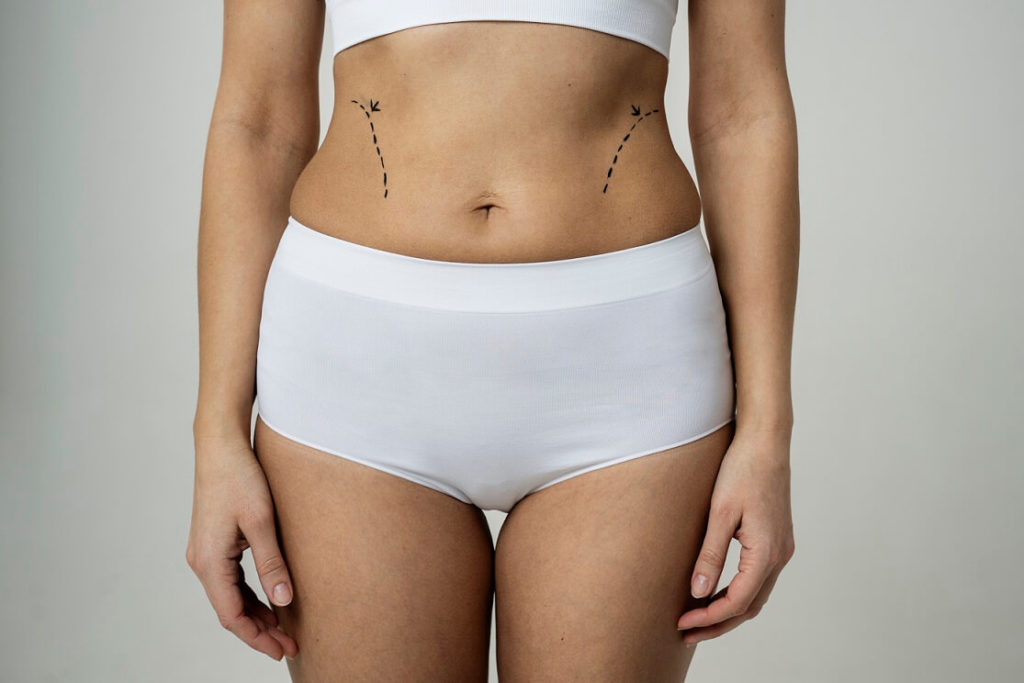Dr. Mark X. Lowney fields various questions from his New England liposuction patients. One frequently asked question is how body fat behaves after liposuction — namely, does it redistribute to other areas of the body? In this blog post, Dr. Lowney breaks down liposuction misconceptions and clarifies how the body stores fat after liposuction. Then, our cosmetic surgeon explains how patients can maximize their liposuction results.
Understanding Liposuction
Liposuction, also known as lipoplasty or just “lipo,” is a popular fat reduction treatment. According to the American Society of Plastic Surgeons statistics, liposuction was among the top five most requested cosmetic surgical procedures in 2021-2022. Liposuction is safe and effective, and fat reduction can look natural and produce long-lasting results.
Men and women seek liposuction to contour areas of the body and destroy excess fat and fat cells that resist diet and exercise. Common areas for liposuction include areas of the body such as the abdomen, hips, thighs, and arms. Lipo works best for individuals who are generally close to their healthy weight range and is not intended for extreme weight loss. While you may lose a few pounds from fat reduction, it’s best to view liposuction as a “finishing touch” method to improve the appearance of certain areas of the body by removing stubborn fat pockets that diet and exercise cannot seem to get rid of.
There are two different types of liposuction: laser-assisted liposuction and power-assisted liposuction. However, all liposuction techniques follow the same basic principles.
Liposuction is a surgical procedure that reshapes the body by suctioning out stubborn fat. The fat is removed through hollow metal tubes called cannulas. These cannulas have an opening near the tip of the tube, which is where the fat gets suctioned. The cannulas are inserted under your skin through small incisions and are attached to a machine that generates energy to help break up and remove fatty tissue. During the procedure, the cannulas are moved back and forth to loosen the fat cells in the target area and make little tunnels through the tissue. This process allows the cannula to break up the fat and suction the fat out of the body and is repeated until the desired amount of fat has been removed.
Benefits of Liposuction
- Reduce excess fat deposits
- Destroy fat cells
- Sculpt and contour the body
- Safe, FDA cleared procedure
- Natural-looking fat reduction
- Long-lasting results
- Scientifically proven as safe + effective
Lipo Treatment Areas
Liposuction can target any deposit of excess fat on the body. Popular treatment areas include:
- Upper and lower abdomen (belly fat)
- Flanks (hips, love handles)
- Buttocks
- Upper arms
- Mons pubis (the pubic region)
- Back and armpit area (bra bulge)
- Inner and outer thighs
- Neck and chin area (double chin)
- Inner knee and calves
Subcutaneous Fat vs. Visceral Fat
Subcutaneous fat and visceral fat are two types of fat found in our bodies. The difference lies in their location and potential health implications.
Subcutaneous fat is the fat that lies just beneath our skin. It acts as a protective cushion and helps insulate our bodies. This fat can be seen and felt like the “love handles” or the layer beneath our skin. While having some subcutaneous fat is normal, excessive amounts can lead to a heavier appearance.
On the other hand, visceral fat is located deeper inside our bodies, surrounding our organs like the liver, pancreas, and intestines. Unlike subcutaneous fat, it cannot be easily seen or felt. Visceral fat is more harmful as it is linked to health issues such as heart disease, diabetes, and high blood pressure.
When liposuction is performed, it targets the subcutaneous fat that is above the muscle. Lipo helps remove localized subcutaneous fat areas, helping reshape those areas and providing a slimmer appearance. However, liposuction cannot remove visceral fat, as it is located within the body and not accessible through this procedure.
An abdomen that protrudes due to fat beneath the muscle or around the internal organs will not be improved with liposuction. To improve visceral fat, the only effective methods are regular exercise and a well-balanced diet.
How Fat Behaves
Now that you have a better understanding of the different types of fat, it is important to understand how fat behaves in the body. First, understand that after adolescence, the number of fat cells in the body does not change. The fat cells increase and decrease in size based on changes in body weight.
Now, remember that liposuction involves removing some or all of the fat cells from a localized area of the body to permanently produce a slimmer and flatter contour. Once these fat cells have been removed from the problematic area(s), they do not grow back. They are gone forever. The body does not have the ability to regenerate fat cells.
What can happen is that after liposuction, the patient gains weight and any remaining fat cells in the treated area can fill up and become larger. Or, if there are no remaining fat cells in the treated area, the fat cells in other areas of the patient’s body enlarge. Overall, if a patient gains weight after having liposuction, the way that their body stores the fat and the fat’s distribution throughout their body will be different than it was before.
This may give the impression that the fat has “shifted” to other areas of the body. However, the fat cells do not become bigger unless there is a fluctuation in body weight. If the body weight remains stable, the fat cells do not change in the treated area or otherwise.
Fat Distribution and Liposuction in Scientific Literature
A common myth about liposuction is that after your procedure, you will have more fat cells in the untreated areas of your body than in the treated areas. However, a study from the Journal of Plastic and Reconstructive Surgery supports evidence that fat cells neither return to treated areas or get redistributed to untreated areas of the body after lipo.
The study assessed over 300 patients who underwent liposuction and evaluated photographs and precise body measurements preoperatively and three months post-op. The study revealed no fat regrowth in treated areas such as the arms, abdomen, or lower body.
Additionally, upper body dimensions were unchanged after surgery, indicating no fat redistribution. Average reductions in hip measurements remained significant in patients followed one year or more after their liposuction procedure. The average hip reduction was significant even among a subgroup of 34 patients who gained five pounds or more after surgery. In conclusion, liposuction patients can be reassured that their results are long-lasting and should not worry about putting weight back on disproportionately.
Maintain Liposuction Results Long-Term
If you recently had liposuction or are considering it in the future, it is a good idea to understand how to maintain the results. You are making a big investment in your body’s appearance, and you want to protect and preserve the outcomes as long as possible. A common misconception after getting liposuction is that you can eat whatever you want and not gain any weight. However, this is not true.
After your lipo procedure, you must maintain your post-liposuction weight to maintain your results. While you will have fewer fat cells, the remaining fat cells can still become larger if you put on weight.
For example, if you weighed 150 pounds before liposuction and had 5 pounds removed from the procedure, fat will not return if the patient maintains their weight at or below 145 pounds.
If the patient gains a couple of extra pounds of weight after lipo, fat cells in the body will get a little bigger. This small weight gain can diminish lipo results. However, the overall improved figure will still be noticeable. Because the areas of the body treated with lipo have less fat cells, they have a lower fat cell enlargement rate than surrounding areas.
The best thing you can do is to maintain a healthy body weight and avoid gaining weight. Eat nutritiously, practice portion control, exercise regularly, and stay active. Many patients find that their newly contoured physique is a motivation to exercise and eat healthfully. For some, removing large pockets of fat can make exercise more comfortable, too.
Ask Your Liposuction Questions
If you desire a slimmer, more sculpted figure, liposuction is a great option to consider helping you achieve natural, long-lasting results. If you have additional questions about liposuction in Pearl River, MA, contact expert surgeon, Dr. Lowney and schedule an informational consultation. You can reach our practice by calling (877) 577-5476.



